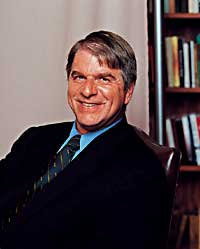 |
||
| uvm a - z | directory | search |
 |
DEPARTMENTS Campaign
Update LINKS
|

photo by Michael Sipe
For
Affirmative Action,
The Clock Is Ticking Down
When the Supreme Court upheld the use of race in college admissions, observers hailed the decision as a victory for affirmative action. Yet embedded in the court’s action last summer is a ticking clock expressed in Justice Sandra Day O’Connor’s majority opinion. “Race-conscious admissions policies must be limited in time,” she wrote. “The Court expects that 25 years from now, the use of racial preferences will no longer be necessary to further the interest approved today.”
Twenty-five
years — think what a desperately short fuse that is. This May we
mark the 50th anniversary of the most historic civil rights ruling of
modern times, Brown v. the Board of Education. We’ve had 50 years,
and yet today, while we can say the glass is better than half full,
more than 20 percent of elementary and secondary school students in
the United States attend schools with minority enrollment ranging from
75 to 100 percent. What’s more, we’re fighting a strong trend
toward resegregation: the percentage of students enrolled in predominantly
single-race schools climbed steadily throughout the last decade.
De facto school segregation and affirmative action in college admissions
are very different but closely related matters, the root causes of the
former being in large measure the same conditions that necessitate the
latter. The point is the tortuous pace of change.
To win the race with that ticking clock, we have to bring American society
to the point at which diversity can be attained through admissions processes
that give no conscious attention to diversity itself. We need to ensure
that all students — African Americans, Hispanics, Asian and Native
Americans, low-income whites, potential first-generation collegians,
and new Americans from around the globe — have equal access to
strong and effective preparation for post-secondary education.
To pursue that goal, the University of Vermont has formed partnerships
with diverse urban high schools designed to ensure that all students
in those schools are encouraged from the ninth grade forward to set
their sights on attending good colleges and universities, that they
know what courses to take in high school to build strong foundations
for college work, and that they and their parents understand how to
apply for admission and for financial aid. And so Christopher Columbus
High School, just off the Pelham Parkway in the Bronx, has become our
largest out-of-state feeder school.
It’s a program that has gained considerable exposure as a national
model and was recently recognized with a 2004 New England Higher Education
Excellence Award. Most importantly, it’s a key part of efforts
to build our diversity that are yielding significant results. In this
year’s applicant pool, we boast a near 39 percent increase in the
number of potential students identifying themselves as African American,
Asian American, Latino, or Native American (from 648 applicants of color
last year, to nearly 900 this spring). But urban partnerships come at
a high cost in time and travel for University staff and in major investments
in financial aid. At a prudent rate of spending of 4.5 percent per year,
it would take an endowment of more than $19 million to support one urban
partnership on the scale we’ve established with Columbus.
The University of Vermont is proud of what we’ve achieved through
urban partnerships, but the daunting dollar figures tell two stories:
why we still need affirmative action as a tool to leverage diversity
in our student bodies — quite simply because there are limits on
the means at our disposal to pursue highly effective remedies that don’t
rely on affirmative action in the admissions process — and how
steep the challenge will be for the whole nation to outrun the clock
ticking away in the Court’s ruling.
—Daniel Mark Fogel
